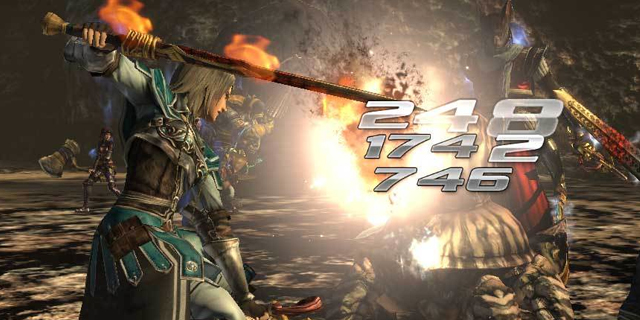
I just started playing Tales of Xillia, the latest entry in one of Namco’s longest-running series. It instantly hooked me with the lavish colors, the grand aspirations, the overly enthusiastic dialogue and an overabundance of exposition in the first few hours. The mechanics feel natural by now; menu systems, experience points, leveling up. Battle strategy and traversing an overworld map have become second nature to me, as I’ve played hundreds of games in this genre. I also get the benefit of playing games that emphasize beautiful worlds and incredible soundtracks. They’re an acquired taste, but I can’t get enough.
That doesn’t mean I always enjoy them.
These kinds of games are ambitious to say the least; you’re looking at a huge amount of text and voiced dialogue, a large amount of varied locations, a soundtrack that’s about triple the size of normal games and a story that, for better or worse, is usually longer and more convoluted than some novels. It takes a lot of people to make a good game; it takes even more to make a great RPG.
It’s a risk. RPGs are long by nature. Bad ones feel even longer. You slog through battle after battle… well, scratch that. I slog through battle after battle, because I’m a glutton for punishment. I try to read reviews and only play the good ones, but sometimes I disagree with either the reviewers or common sense and attempt to play RPGs that aren’t critically acclaimed. On top of that, they’re also punishingly difficult. I’m not sure what I was thinking when I tried playing The Last Remnant.
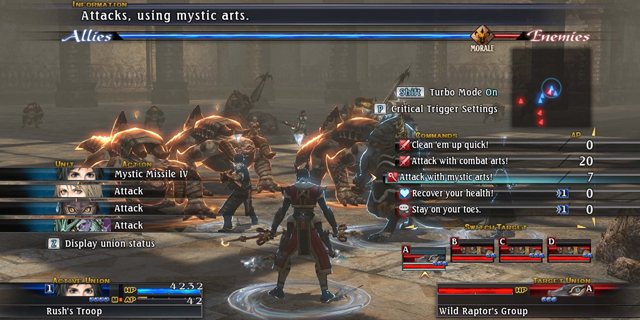
The Last Remnant is a Japanese RPG released on the Xbox 360 in late 2008 and for the PC in early 2009. It’s a game made by perennial RPG giant Square Enix. The game has a distinctive look, and runs great on my PC. Some areas look fantastic. Some areas are very bland, but I’m going to have to give the game some credit; it has some cool ideas. Cities are based around “Remnants”, giant artifacts that grant people various powers. It’s a neat contrast, as the cities themselves aren’t very fantastical and the world feels gritty and realistic in parts. It was also Square Enix’s first simultaneous international release, as well as the first time it used motion captures of Western actors to make the lip-syncing look good. Nicely done.
Small amounts of praise aside, this game is demonic. I don’t know what masochist thought up the core design of this game. The game feels about half-finished after the first 10 hours, and after the next 20, I’m seriously thinking they shipped the wrong file. You play as Rush Sykes, but I gave up caring about the plot quickly. This game offers you little explanation and makes no apologies for it. It’s as if Square Enix heard the fans want a “hardcore” game, so it made this one as impossible as possible.
You play with an army of characters. That’s good! Multiple personality types and battle strengths usually mean a diverse combat system that lends itself well to experimentation and customization. What the game doesn’t tell you is that each character has an individual experience bar for weapons skills, techniques, classes, specializations and overall level. But you can’t see them. Any of them. I didn’t even know they existed until I read up about it online. You won’t know anything about the classes, or what they do. Apparently there’s a massive skill tree for everything, and it all goes depending on how you use a character. Remember, you can’t see it. You don’t know it exists. The game doesn’t tell you.
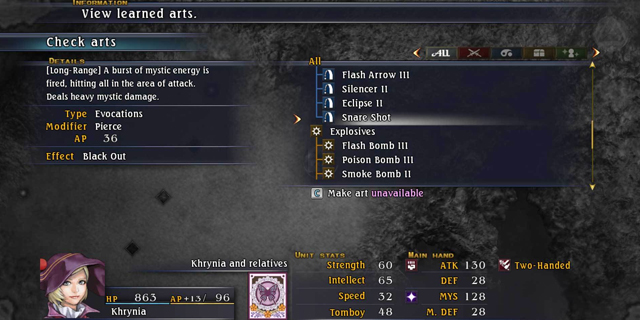
I’ve heard this game isn’t for everybody. I would argue that it’s barely for anybody. In order to win the game and beat some of the ludicrously-difficult bosses, you have to plan everything. Everything. From when and how to get specific characters, to speaking to random townsperson number six so a monster in another area will drop item 17 so you can craft that weapon you need. Did I mention the game doesn’t tell you any of this?
I thought I knew what I was doing, and I thought I felt comfortable playing RPGs. The Last Remnant showed me how little I know, and how little it cares about me. Remember The Last Starfighter? Where an alien defense force picks Alex Rogan because he’s really good at the arcade game Starfighter? I don’t know what interstellar, angelic, futuristic society needs our help, but to whoever beats The Last Remnant and figures everything out without months of study online: best of luck to you in your adventure against evil forces on a distant planet or alternate reality.
Playing this game felt like reading a book, only to have the language switch from English to French halfway through, then find out that it’s a choose your own adventure and the text has been flipped upside-down. Then you come to a blank page. Sorry! You can’t finish the book until you go back and read it again with your eyes closed.
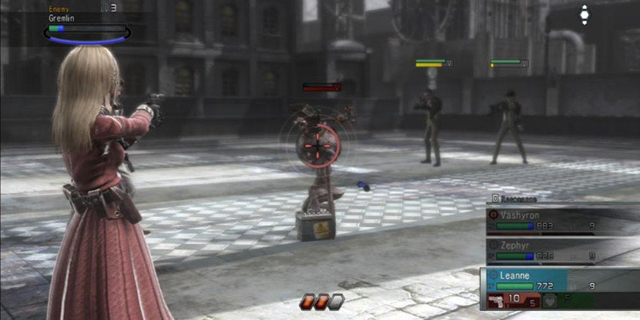
Resonance of Fate wasn’t nearly as cryptic as The Last Remnant, but it’s one of the hardest RPGs I’ve played. It didn’t make me question my sanity, but it did teach me a tough lesson. It’s a lesson children learn at about the age of three. When learning something, you should pay attention. That simple.
Resonance of Fate, released in early 2010, was made by tri-Ace, a veteran developer of RPGs such as the Star Ocean series, Infinite Undiscovery and Valkyrie Profile. This isn’t its first rodeo. Once again, it made an incredibly cool world. It’s a mix of steampunk and post-apocalyptic (yeah yeah, seen it a hundred times, I know), but the visual style works really well. The presentation is a mix of John Woo and Final Fantasy. You’ve got your tropes of ridiculous mannerisms that plague JRPGs, but you’ve also got fantastic-looking cities and a great soundtrack. I wish these games wouldn’t do such a great job of luring me in, it would be easier to stop playing when the enjoyment sinks.
Something awful has happened to the earth and, for unknown reasons, the land is covered in poisonous gas that nearly exterminated humans. They built a giant tower called Basel which purifies the air, allowing people to live there. I’m missing a hundred small details, but trust me, knowing is not half the battle here.
The battle system is unlike anything I’ve played before, which doesn’t necessarily mean it’s bad. It’s a mix of real-time and turn-based controls. You control three characters in battle throughout the game, one at a time. Once it’s their turn, you can run, jump and shoot enemies. Everything else is frozen until your turn is over. Likewise, you’re frozen when it’s not your turn. It bodes well for you not to leave your backside prone to enemy fire, so planning is needed.
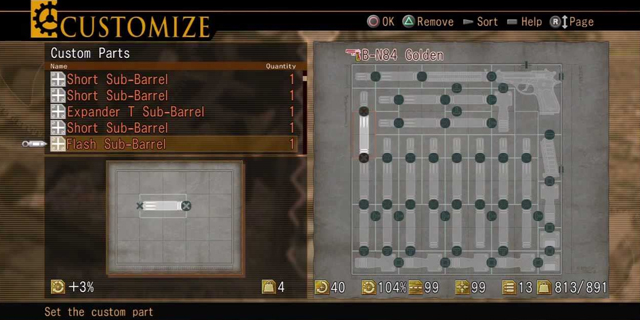
There’s two types of damage: “scratch” and “direct.” Scratch damage can be dealt by machine guns and can’t actually kill enemies, but reduces their armor, leaving them prone to direct damage (dealt by pistols and grenades). There are many other factors that affect gameplay, but in the interest of brevity, I’ll just skip right to the point: you can customize your guns in really fun, impossible ways. You can add on extra ammo clips, scopes and handles to improve the power and speed of your weapons. They have to fit in to an already-attached piece, so some fiddling is required.
The game’s challenge was only superseded by my own stupidity. The learning curve is more of a cliff, but it didn’t help that I didn’t pay attention or do any research. Customizing your gun and maximizing the potential of your attachments is the best way to get through the game, but I didn’t find out, until the very last boss, that you can move your gun around on the grid, greatly increasing the amount of space you can use. Brilliant. Only took me 52 hours of gameplay and a trip to the Internet to find out. I also didn’t know that I could rotate the customizable parts by simply pressing the L and R buttons. Again, this is a major feature and a large part of the gameplay, and I completely missed it. There should be a warning label on the game: “lack of intelligence may affect gameplay.”
The story never really develops, but I seriously hope for another game in this world. It doesn’t necessarily have to be a sequel, but I hate seeing good creations go to waste. It also didn’t help that I didn’t pay attention and failed to use all the options the developers gave me to trudge through the difficult dungeons and overwhelming mechanics. I felt just like I did when I locked my keys in the car, with the car running. Three times.
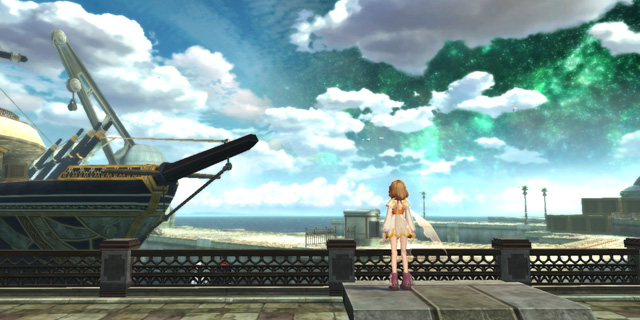
The Last Remnant is impossible by design, and Resonance of Fate was made exponentially more difficult by my own failings. Tales of Xillia will be a nice change of pace; I’m almost positive it won’t drive me to the brink of insanity, and I haven’t read anything on it being particularly difficult. Just to be sure, I put the battles on normal difficulty.



















